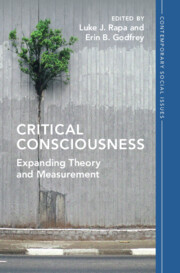Book contents
- Critical Consciousness
- Contemporary Social Issues
- Critical Consciousness
- Copyright page
- Dedication
- Contents
- Figures
- Tables
- Contributors
- Acknowledgments
- Introduction Critical Consciousness Theory and Measurement
- Part I Theory
- Part II Measurement
- 7 Critical Consciousness Measurement
- 8 Using Social Network Analysis to Identify Individual and Structural Precursors for Promoting Critical Consciousness in Childhood and Adolescence
- 9 Conceptualizing Adolescents’ Daily Critical Consciousness
- 10 Measurement and Analysis in Quantitative Critical Consciousness Research
- 11 The Development of the Contemporary Critical Consciousness Measure-Short
- Conclusion Expanding Critical Consciousness Theory and Measurement
- Index
- References
9 - Conceptualizing Adolescents’ Daily Critical Consciousness
A Model and Research Agenda
from Part II - Measurement
Published online by Cambridge University Press: 20 April 2023
- Critical Consciousness
- Contemporary Social Issues
- Critical Consciousness
- Copyright page
- Dedication
- Contents
- Figures
- Tables
- Contributors
- Acknowledgments
- Introduction Critical Consciousness Theory and Measurement
- Part I Theory
- Part II Measurement
- 7 Critical Consciousness Measurement
- 8 Using Social Network Analysis to Identify Individual and Structural Precursors for Promoting Critical Consciousness in Childhood and Adolescence
- 9 Conceptualizing Adolescents’ Daily Critical Consciousness
- 10 Measurement and Analysis in Quantitative Critical Consciousness Research
- 11 The Development of the Contemporary Critical Consciousness Measure-Short
- Conclusion Expanding Critical Consciousness Theory and Measurement
- Index
- References
Summary
Critical consciousness, or the process of coming to understand and combat oppression, is an integral aspect of adolescents’ sociopolitical development and is necessary for collective liberation. Although adolescents interface with oppression daily, little is known about how they engage in critical consciousness or how this process manifests across different situations and contexts. In this chapter, we propose a conceptual model and research agenda aimed at capturing this complexity. Specifically, we argue that daily diary studies would be well positioned to examine the finer-grained temporal nature of critical consciousness and intraindividual variability. We provide an overview of how daily diaries might be applied to the study of critical consciousness. Additionally, we discuss implications for research, practice, and policy.
Keywords
- Type
- Chapter
- Information
- Critical ConsciousnessExpanding Theory and Measurement, pp. 228 - 252Publisher: Cambridge University PressPrint publication year: 2023

